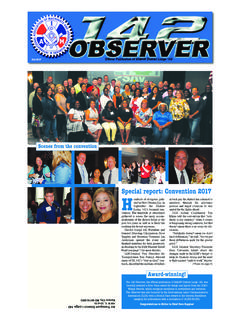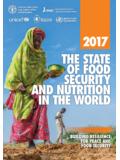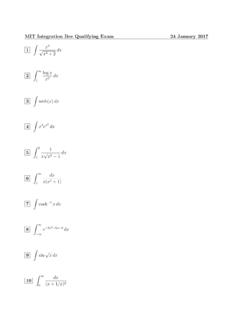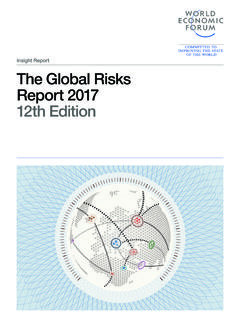Transcription of FAO Statistical Programme of Work 2016-2017
1 FAO. Statistical . Programme . OF WORK. 2016-2017 . The designations employed and the presentation of material in this information product do not imply the expression of any opinion whatsoever on the part of the Food and Agriculture Organization of the United Nations (FAO) concerning the legal or development status of any country, territory, city or area or of its authorities, or concerning the delimitation of its frontiers or boundaries. The mention of specific companies or products of manufacturers, whether or not these have been patented, does not imply that these have been endorsed or recommended by FAO in preference to others of a similar nature that are not mentioned. The views expressed in this information product are those of the author(s) and do not necessarily reflect the views or policies of FAO.
2 FAO 2017 . FAO encourages the use, reproduction and dissemination of material in this information product. Except where otherwise indicated, material may be copied, downloaded and printed for private study, research and teaching purposes, or for use in non-commercial products or services, provided that appropriate acknowledgement of FAO as the source and copyright holder is given and that FAO's endorsement of users' views, products or services is not implied in any way. All requests for translation and adaptation rights, and for resale and other commercial use rights should be made via or addressed to FAO information products are available on the FAO website ( ) and can be purchased through i Table of Contents SECTION ONE: Statistics at FAO and the FAO Corporate Statistical Programme of 1.
3 1. Introduction .. 2. 2. Statistics at FAO .. 2. 3. FAO Statistical Governance .. 2. 4. The Quality Assurance and Planning Survey (QAPS) .. 3. 5. Statistical Programme of Work 2016-2017 : Key facts .. 4. Appendix 1: FAO units that contributed to the 8. Appendix 2: Number of activities reported in the QAPS by function and department .9. Appendix 3: Activity list by CSA code .. 10. SECTION TWO: Activity list and 18. ii SECTION ONE. Statistics at FAO and the Corporate Statistical Programme of Work 1. 1. Introduction The FAO Corporate Statistical Programme of Work (SPW) provides an overview and a detailed description of the Statistical activities carried out by all FAO divisions active in the field of statistics. In 2010, the first SPW 2010 2011 was compiled to provide a clear overview of ongoing Statistical work at FAO.
4 Since then it has become a regular activity. This is the fourth version of the FAO Statistical Programme of Work and it covers the 2016 . 2017 biennium. 2. Statistics at FAO. Statistics is a core function of FAO and represents a highly visible area of the Organization's work. The heightened emphasis on evidence-based decision-making in governments and organizations at all levels puts a greater focus on the role of statistics and the part it must play in measuring and monitoring progress towards national and international development goals and targets. Allied to appropriate policies, sound and timely statistics are instrumental in making a positive impact on the lives of poor and vulnerable people. The FAO Statistical System works at the forefront of these issues and plays an essential role in helping FAO Member countries to reduce hunger and poverty by making informed decisions through access to the best possible data.
5 FAO is recognized as having a fundamental global role in providing data for global monitoring, developing methods and standards for food and agriculture statistics and providing technical assistance services. In addition to maintaining the collection, processing and dissemination of existing data series, there are increasing demands for new statistics and for advanced integration of data and information. FAO also plays a leading role as the custodian for 21 Sustainable Development Goal (SDGs). indicators, which will drive the international Statistical agenda for the next 15 years and beyond. 3. FAO Statistical Governance In 2013, FAO formulated a new Strategic Framework1 to ensure that FAO will achieve visible and measurable country-level results.
6 Statistics has a vital role to play in achieving these results, by targeting those in need, identifying which interventions are required and where, and assessing and monitoring the impact made by policies, programmes and projects. 1. FAO Strategic Objectives 2. To this end, the FAO Administrative Circular on Statistics Accountability Framework . (2015/22) issued in November 2015, sets out a new accountability framework for FAO's Statistical activities and gives the Chief Statistician responsibility for guaranteeing the quality of FAO data. The position of the Chief Statistician was created to manage the overall governance and coordination of the FAO Statistical system and provide technical leadership and guidance on how Statistical activities should be carried out at FAO in order to meet the quality standards defined in the FAO Statistics Quality Assurance Framework (SQAF)2.
7 The Chief Statistician is supported by the Interdepartmental Working Group (IDWG) on Statistics that constitutes a coordination mechanism with the recognized authority to make decisions of corporate relevance. The membership comprises all units within FAO concerned with the collection, processing, analysis and dissemination of statistics, including the Regional Offices. It promotes interdivisional coordination and cooperation on Statistical programmes, as well as corporate consistency and alignment in Statistical practices. 4. The Quality Assurance and Planning Survey The FAO Statistical Programme of Work (SPW) provides an overview of the key outputs, activities, priorities and areas for development in statistics. It is intended for both internal and external use, as a quick guide to the substantial and complex FAO Statistical System.
8 The SPW is an important tool for improving internal transparency and coordination, as well as the external visibility of the FAO Statistical System, and for achieving effective coordination and stimulating joint efforts among international organizations in many areas. Indeed, within this global framework, duplicative and complementary activities can be identified, as well as areas where there is a potential for joint ventures, outsourcing and specialization. As in the previous version, activities in SPW 2016 2017 are coded according to the Classification of Statistical Activities3 (CSA) to facilitate information exchange with other international organizations. Information on each activity has been collected through the Quality Assurance and Planning Survey (QAPS), which is a new online tool designed to gather comprehensive information on all of FAO's Statistical activities.
9 It replaces the survey that was used in past years to develop the FAO Statistical Programme of Work, and collects information on an annual basis about what the activities are and how they are being carried out, with the goal of increasing compliance with the FAO SQAF. The QAPS is organized around the following five Statistical functions: 2. 3. 3. 1. Data Output From Data Collection to Dissemination (QAPS questionnaires # 1-2). FAO's work on the collection and dissemination of Statistical information on food and agriculture represents a core element of the Organization's mandate. From its inception, FAO has endeavoured to maintain the best possible capacity to collect, process, validate, harmonize and analyse incoming data and generate accurate and timely information.
10 Improving the quality, transparency, and access to FAO's Statistical data is an important priority. 2. Analytical Publications (QAPS questionnaire # 3). FAO analysts play a crucial role in compiling and modelling data in order to extract information, conclusions, and recommendations, and to support decision-making. These activities do not necessarily entail data collection and are often based on information collected through activities under the Data output function. Key outputs consist of analytical publications, technical reports, papers and bulletins. FAO Statistical flagship publications are also reported here. 3. Statistical Standards (QAPS questionnaire # 4). FAO is recognized as having an essential role in developing methods, standards and principles for food and agriculture statistics.

















